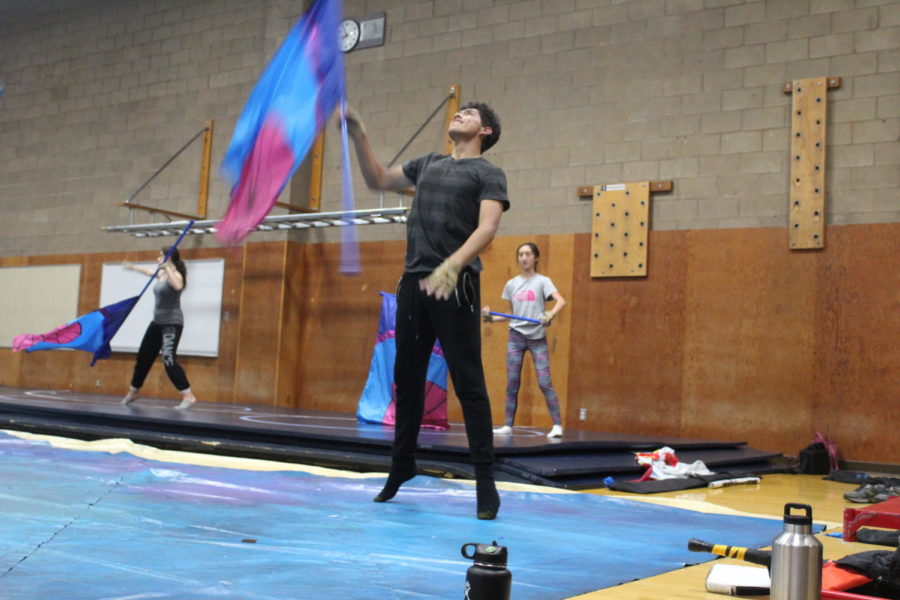Winter Guard Works Hard to Win Upcoming Competitions
Senior Alex Aguilar twirls a flag at practice.
January 26, 2018
Following their achievements during the field season, in which they placed first in every single field show and second place at Southern Division Championships, UC High’s Color Guard Team, in Division Scholastic AA, hopes to continue their winning streak as they transition into the winter season.
“Winter guard is a visual performing arts sport where we dance and use flags, rifles, and sabres,” said Junior Co-Captain Lauren Hosmer.
“We compete against other schools and are judged based on our dancing, performance, and how well we spin our weapons and flags. We’re also judged on how difficult the routine is,” said Senior Head Captain Isabel Coupland.
According to the World’s Premier Organization that produces indoor color guard, percussion, and winds competitions, winter guard is the sport of arts; it derives from color guard, which is an outdoor-based sport that competes along with a marching band (wgi.org).
“Color guard is during marching season [fall], and we perform the shows on a football field with the band. During winter guard season [winter and spring], we perform our entire show on a floor that we pull out for competitions and performances, usually in gyms,” said Hosmer.
“I like it [winter guard], because it’s more personal, and it’s more close. You don’t have to worry about being spread out on a football field, and it’s all contained in a gym,” said Senior Co-Captain Camryn Taub.
This year is also the first year in the history of the UC High Color Guard Team that they will be attending Regionals. “We’re super excited,” said Taub. “It’s [Regionals] getting us out there, and it’s helping us witness better color guard teams that we usually wouldn’t be able to see, like international color guards. We’re really just looking forward to it more because of the experience and not so much winning,” she continued.
With lots of competitions coming up and one right around the corner, the team has been putting all their time and effort into their practice sessions. “We currently practice two times a week for about three-and-a-half-hours each. We also have occasional all-day Saturday practices,” said Coupland. During these practices, the team does a lot; ranging from their coaches teaching the team choreography to briefing them with the concept of the show. “With all of our practices, it’s just us [coaches and color guard team]. There are no outside distractions, and this is when you really start to get that bond with your team and start making friends in color guard,” said Taub.
The coaches are also an essential part of the team, as they make most of the decisions and style choices. “My coaches are in charge of a huge list of things. They control how the show looks overall, along with the choreography, the flag work, rifle work, sabre work, and drill,” said Hosmer. “They then choose our costumes, our hairstyles, and what makeup look we do, as well as our practice days and times. There is still so much more. I’m really grateful for all three of my amazing coaches: Greg Humphrey, Kekoa Mateo, and Heather Serdoz,” she continued. “They teach us everything that we know really,” said Taub.
Along with practice comes dedication and the willingness to commit yourself to being the best you possibly can. “I would say that color guard is extremely hard, but like any other sport, you have to work at it and practice to become better,” said Hosmer. “When you first start color guard, it’s hard because everything is new. As you practice more it gets a little easier, but there are always new tricks that are hard to master,” said Coupland.
Their outfits are also key for their competitions and performances. “Our costumes are pretty expensive. I’m not sure the actual cost, but it is upwards of 200 dollars per uniform,” said Hosmer. “Our uniforms are about 300 dollars, a flag with a silk is about 50 dollars, a rifle is 50 dollars, and a sabre is 250 dollars,” said Coupland.
Although winter guard is just a transition from fall into winter and spring, the dedication and liveliness of the team is still present and strong. “There are so many things that I love about winter guard, but if I had to choose one, it’s the feeling of when I know we all had a wonderful show and the feeling of all of us being connected,” said Hosmer.


